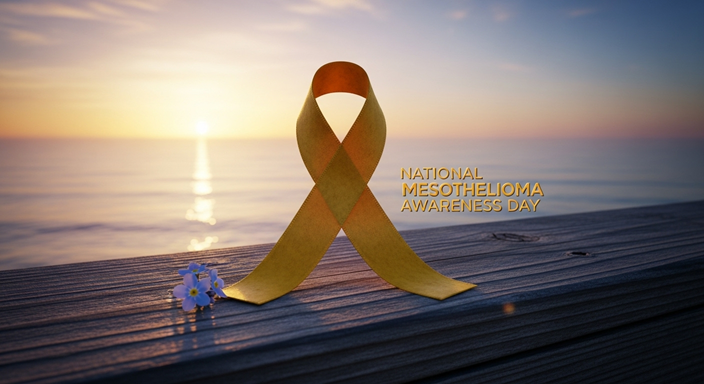Every year, National Mesothelioma Awareness Day is observed with a strong voice against one of the #deadliest yet lesser-known #cancers caused by #asbestos exposure. Marked on September 26, the day raises global #awareness, honors #patients and #survivors, and #unites communities in the fight for better #research, #treatment, and ultimately, a #cure. Since its inception, the movement has grown significantly, giving a platform to thousands of voices demanding #justice and #change. The goal is to shed light on the #dangers of #asbestos and inspire solidarity. #NationalMesotheliomaAwarenessDay is more than just a campaign—it is a reminder of #resilience, #hope, and #action.
History of Mesothelioma Awareness Day
National Mesothelioma Awareness Day was first officially recognized in 2004, when the Mesothelioma Applied Research Foundation (MARF)—a nonprofit dedicated to eradicating mesothelioma and supporting patients—spearheaded the campaign. The initiative gained traction with the support of patients, families, healthcare professionals, and advocacy groups who had witnessed the devastating impact of mesothelioma firsthand.
In the early years, the goal was to ensure the public understood mesothelioma was not a “rare unknown cancer” but a real, pressing issue linked to asbestos exposure in homes, schools, workplaces, and military settings. By 2010, the U.S. Congress passed a resolution officially recognizing September 26 as National Mesothelioma Awareness Day, making it a national observance.
The history of this day reflects decades of advocacy—from workers’ unions to legal groups—that demanded recognition of asbestos victims. Over time, it has grown into an international movement, with global awareness events shining light on both prevention and cure.
Importance of Mesothelioma Awareness Day
The importance of National Mesothelioma Awareness Day lies in its multi-dimensional goals:
-
Raising Awareness: Many people still do not know what mesothelioma is, its symptoms, or its connection to asbestos. Awareness can save lives through early detection.
-
Driving Research Funding: Mesothelioma remains one of the most underfunded cancers despite its severity. Awareness campaigns push for financial support toward clinical trials and innovative treatments.
-
Supporting Patients & Families: The disease impacts entire families emotionally and financially. The day creates a space for empathy, sharing stories, and building community support networks.
-
Policy & Advocacy: The day underscores the urgent need for stricter regulations and bans on asbestos use globally, pressing governments to prioritize public health.
In essence, the day is important because it transforms personal battles into collective advocacy, pushing humanity closer to prevention and cure.
Significance of Mesothelioma Awareness Day
The significance of National Mesothelioma Awareness Day is rooted in the intersection of science, policy, and humanity. While mesothelioma is rare, it is aggressive and often diagnosed late. The average survival rate after diagnosis is tragically low, yet this day highlights:
-
Global Health Priorities – It raises attention to occupational health hazards often overlooked.
-
Justice & Accountability – Many victims were unknowingly exposed to asbestos in workplaces, military services, or schools. This day demands accountability.
-
Inspiration & Unity – Survivors’ stories and remembrance ceremonies highlight courage and resilience, reminding society of the human spirit in adversity.
The significance is not only medical but also social, political, and emotional. It ensures that those who lost their lives are remembered, those fighting feel supported, and future generations are protected.
Why Mesothelioma Awareness Day is Celebrated
National Mesothelioma Awareness Day is celebrated to keep the fight alive against a silent yet deadly disease. The reasons include:
-
To commemorate and honor patients who have lost their lives.
-
To provide strength to current patients and their families.
-
To push for a complete global ban on asbestos, which continues to be used in some industries despite its known dangers.
-
To highlight breakthroughs in treatment and celebrate survivors.
-
To unite healthcare workers, researchers, and advocates in a global call for change.
The celebration is both a memorial and a movement—rooted in remembrance but driven by the hope of a future without mesothelioma.
How Mesothelioma Awareness Day is Celebrated
Celebrations and observances of National Mesothelioma Awareness Day vary worldwide but typically include:
-
Awareness Events & Walks: Communities host charity walks, runs, and marathons to raise funds.
-
Candlelight Vigils: In memory of those who lost their lives, families and friends gather for solemn remembrance.
-
Educational Seminars: Universities, hospitals, and advocacy groups organize talks to spread awareness.
-
Fundraising Campaigns: Nonprofits raise donations to fund mesothelioma research.
-
Media Campaigns: Social media hashtags, videos, and survivor stories go viral to reach younger audiences.
-
Blue Ribbons: The color blue represents mesothelioma awareness; people wear ribbons to show solidarity.
The celebrations balance hope and remembrance, creating an atmosphere where loss fuels the drive for future progress.
Countries Where Mesothelioma Awareness Day Is Celebrated
National Mesothelioma Awareness Day is primarily recognized in the United States, where it originated. However, awareness has spread globally, particularly in countries heavily affected by asbestos-related diseases, such as:
-
United Kingdom: With a high incidence of asbestos-related illnesses due to past industrial exposure.
-
Australia: Known for its historical asbestos mining, especially in Wittenoom.
-
Canada: Where asbestos was widely used in construction and shipbuilding.
-
European Union nations: Where asbestos has been banned but its lingering impact continues.
-
Parts of Asia and Latin America: Where asbestos use is still legal, and awareness campaigns are crucial.
Though the day has an American origin, its global resonance makes it significant across continents.
How Citizens Involve Themselves
Citizens play a central role in making the day successful. Their involvement includes:
-
Sharing Stories: Patients, survivors, and families use social media to create a ripple effect of awareness.
-
Participating in Walks or Fundraisers: Ordinary people join events that channel funds into research.
-
Educating Communities: Volunteers visit schools, colleges, and workplaces to educate about asbestos dangers.
-
Advocacy: Citizens lobby local governments to enforce stricter regulations on asbestos.
-
Wearing Blue: A small but impactful gesture to show solidarity.
-
Creating Art, Music, or Memorials: Citizens use creativity to honor victims and inspire hope.
Every individual effort strengthens the collective voice, proving that awareness begins with people, not just institutions.
Theme for Mesothelioma Awareness Day 2025
The official theme for National Mesothelioma Awareness Day 2025 is expected to focus on “Breaking Silence, Building Hope.”
This theme reflects two crucial aspects:
-
Breaking Silence – Encouraging open conversations about asbestos, mesothelioma risks, and policy failures.
-
Building Hope – Focusing on medical advancements, survivor stories, and the resilience of communities.
The theme symbolizes the transition from awareness to active change and optimism for future generations.
10 Famous Quotes for Mesothelioma Awareness Day
-
“Awareness is the first step to prevention, and prevention is the key to saving lives.”
-
“Behind every mesothelioma statistic is a story of courage and resilience.”
-
“We honor the lost by fighting for the living.”
-
“Silence is dangerous—awareness is powerful.”
-
“Every blue ribbon worn is a promise for change.”
-
“Mesothelioma is not rare to those who live with it every day.”
-
“Hope is the bridge between awareness and cure.”
-
“Asbestos is man-made, but together we can create a world free from its harm.”
-
“Courage doesn’t mean you don’t get afraid—it means you don’t let fear stop you.”
-
“National Mesothelioma Awareness Day is not just a date; it’s a movement.”
FAQs
Q1: What is Mesothelioma?
Mesothelioma is a rare but aggressive cancer caused mainly by asbestos exposure. It affects the lining of the lungs, abdomen, or heart.
Q2: When is National Mesothelioma Awareness Day observed?
It is observed annually on September 26.
Q3: Who started this awareness day?
It was initiated in 2004 by the Mesothelioma Applied Research Foundation (MARF) and later recognized by the U.S. Congress.
Q4: Why is asbestos dangerous?
Asbestos fibers, when inhaled, remain in the lungs and cause severe scarring, inflammation, and cancers like mesothelioma.
Q5: Is mesothelioma preventable?
Yes. Avoiding asbestos exposure is the key to prevention. Bans and regulations can significantly reduce risks.
Q6: What is the survival rate for mesothelioma?
The average survival time after diagnosis is around 12–21 months, though some patients live longer with treatment advancements.
Q7: How can I support National Mesothelioma Awareness Day?
You can participate in events, donate to research foundations, wear blue ribbons, and spread awareness on social media.
Q8: Which countries are most affected by mesothelioma?
The U.S., U.K., Australia, Canada, and parts of Europe are significantly affected, though cases are rising in countries where asbestos is still legal.
Q9: What is the symbol of Mesothelioma Awareness?
The blue ribbon is the symbol representing mesothelioma awareness.
Q10: What is the theme of 2025?
The 2025 theme is “Breaking Silence, Building Hope.”
Conclusion
National Mesothelioma Awareness Day is not just a commemoration—it is a powerful global movement for change. Since its recognition in 2004, the day has served as a platform to honor victims, uplift survivors, and amplify the urgent call for a world free from asbestos. Its importance lies not only in spreading knowledge but also in shaping a future where such tragedies can be prevented.
The observance reminds us that every action counts—whether it is sharing awareness, joining a fundraiser, or simply wearing a blue ribbon. In 2025, with the theme “Breaking Silence, Building Hope,” society is called upon to act with courage, compassion, and determination.
Mesothelioma may be a devastating disease, but through awareness, advocacy, and collective action, hope remains stronger than despair.
|
!!! Stay Updated !!! 👉 Follow and Join us on 👈 📰 Trending News | 📢 Important Alerts | 💼 Latest Jobs LinkedIn | Threads | Facebook |Instagram | Tumblr 📱 Follow us daily & never miss an update 📱 |

Someshwar Chowdhury is a seasoned Chartered Mechanical Engineer, Educator, and Technology enthusiast with over a decade of experience in engineering education and consultancy. Someshwar is also an active blogger, trainer, and member of professional bodies like ISHRAE and GREEN ADD+. When not teaching or consulting, he enjoys blogging, music, and exploring green technologies.
Discover more from Today's Significance
Subscribe to get the latest posts sent to your email.
